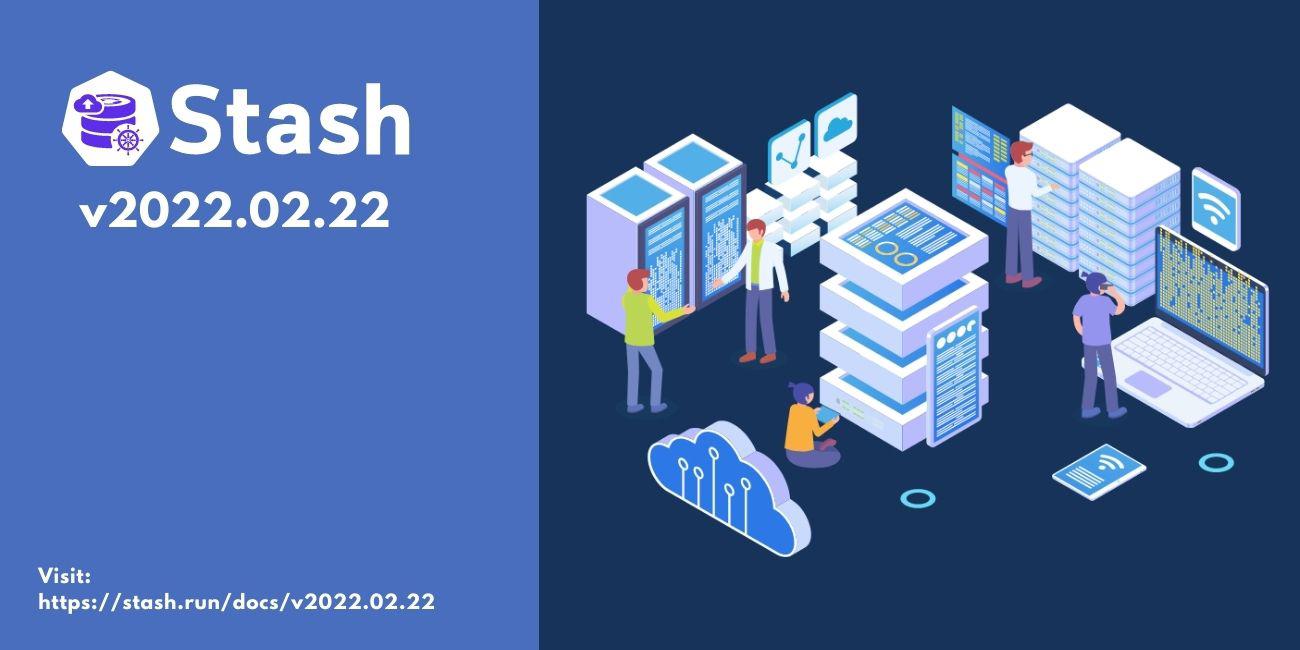
We are very excited to announce Stash v2022.02.22. In this release, we have introduced some exciting features and fixed some bugs. You can find the complete changelog here
. We are going to highlight the major changes in this post.
New Features
Here, we are going to highlight the new features that have been introduced in this release.
Support cross-namespace Repository reference
We are introducing support for cross-namespace Repository reference. Now, you can refer to a Repository in BackupConfiguration and RestoreSession from different namespaces. So, you can now easily restore into different namespaces without copying the Repository or you can keep your Repository and backend Secret isolated from the application namespaces where the backup happens.
To support this feature, we are introducing the spec.usagePolicy field in the Repository CRD. This lets you control which namespaces are allowed to use the Repository and which are not. If you refer to a Repository from a restricted namespace, Stash will reject creating the respective BackupConfiguration/RestoreSession from validating webhook.
You can use the usagePolicy to allow only the same namespace, a subset of namespaces, or all the namespaces to refer to the Repository.
For example, here is the sample YAML of a Repository that allows referencing it from all namespaces.
apiVersion: stash.appscode.com/v1alpha1
kind: Repository
metadata:
name: s3-repo
namespace: demo
spec:
backend:
s3:
endpoint: s3.amazonaws.com
bucket: stash-demo
region: us-west-1
prefix: /backup/demo/deployment/stash-demo
storageSecretName: s3-secret
usagePolicy:
allowedNamespaces:
from: All
Here, is the example of a Repository that allows referencing it only from the same namespace.
apiVersion: stash.appscode.com/v1alpha1
kind: Repository
metadata:
name: s3-repo
namespace: demo
spec:
backend:
s3:
endpoint: s3.amazonaws.com
bucket: stash-demo
region: us-west-1
prefix: /backup/demo/deployment/stash-demo
storageSecretName: s3-secret
usagePolicy:
allowedNamespaces:
from: Same
Finally, here is the example of a Repository that allows referencing it only from prod and staging namespaces.
apiVersion: stash.appscode.com/v1alpha1
kind: Repository
metadata:
name: s3-repo
namespace: demo
spec:
backend:
s3:
endpoint: s3.amazonaws.com
bucket: stash-demo
region: us-west-1
prefix: /backup/demo/deployment/stash-demo
storageSecretName: s3-secret
usagePolicy:
allowedNamespaces:
from: Selector
selector:
matchExpressions:
- key: "kubernetes.io/metadata.name"
operator: In
values: ["prod","staging"]
Introducing phase in BackupConfiguration status
We have added a phase field to the BackupConfiguration status. This can help you understand the backup setup status.
Currently, the phase field accepts the following values:
Invalid: It indicates that the BackupConfiguration has failed the validation check. It can happen when the BackupConfiguration refers to a Repository of a different namespace and the current namespace is not allowed by the
usagePolicyof the Repository.NotReady: It indicates that the backup setup is not completed yet. It can happen when some dependency (i.e. Repository, backend Secret, etc.) are missing, or Stash hasn’t completed processing the BackupConfiguration yet. You can describe the BackupConfiguration to check why it is in the
NotReadystate.Ready: It indicates that the backup setup was completed successfully and the backup will be triggered from the next schedules.
Introducing Invalid phase in RestoreSession status
We have added an Invalid phase in the RestoreSession status. It indicates that the RestoreSession has failed the validation check. This can happen when the RestoreSession references a Repository of a restricted namespace.
Support cross-namespace Service reference in AppBinding
AppBinding now supports referencing Services of a different namespace. This can help you to backup a database from a different namespace.
Support URL in the AppBinding
Stash now supports referencing your application via a URL in AppBinding. This allows you to backup/restore databases located outside of your Kubernetes cluster.
Custom Pushgateway support
You can now use your custom pushgateway to push Stash metrics. If you use a custom pushgateway, Stash will not inject the pushgateway sidecar to the operator. You can now pass the following helm flag during installation to use the custom pushgateway.
# For community edition
--set stash-community.pushgateway.customURL=<your pushgateway url>
# For enterprise edition
--set stash-enterprise.pushgateway.customURL=<your pushgateway url>
Show Snapshot ID in kubectl get snapshots command
We have added Snapshot ID in the response to the kubectl get snapshots command. This helps you easily identify the Snapshot ID which is necessary to restore a particular Snapshot.
Add pause and resume commands to Stash kubectl plugin
We have added two useful commands to our Stash kubectl plugin. You can now easily pause and resume your backup using the commands.
For example, to pause a backup, you can run:
kubectl stash pause --backupconfig=sample-mongo-backup -n demo
To resume the backup, you can run:
kubectl stash resume --backupconfig=sample-mongo-backup -n demo
Support for M1 Mac in Stash kubectl plugin
We have added support M1 Mac in our Stash kubectl plugin.
Bug Fixes
Now, here are a few bugs we have squashed in this release.
Fix broken download command in Stash kubectl plugin
You can now again run the kubectl stash download command to download a snapshot to your local machine.
Always keep the last completed BackupSession
Now, Stash will always keep the last completed BackupSession when backuphistorylimit>0. It will keep the last completed BackupSession even if it exceeds the history limit. This will help to keep the backup history when a backup gets skipped due to another running backup.
Deprecation and Cleanup
In this release, we have removed the deprecated v1alpha1 APIs. This means the Restic and Recovery CRDs are no longer available in Stash.
Documentation Improvements
Now, here are a few improvements we made on the documentation side.
- Removed deprecated documentation
- Add docs for cross namespace Repository reference.
- Added troubleshooting guides that show how to identify and fix common Stash issues.
- Improved addon documentations
What Next?
Please try the latest release and give us your valuable feedback.
- If you want to install Stash in a clean cluster, please follow the installation instruction from here .
- If you want to upgrade Stash from a previous version, please follow the upgrade instruction from here .
Support
To speak with us, please leave a message on our website .
To receive product announcements, follow us on Twitter .
If you have found a bug with Stash or want to request new features, please file an issue .










